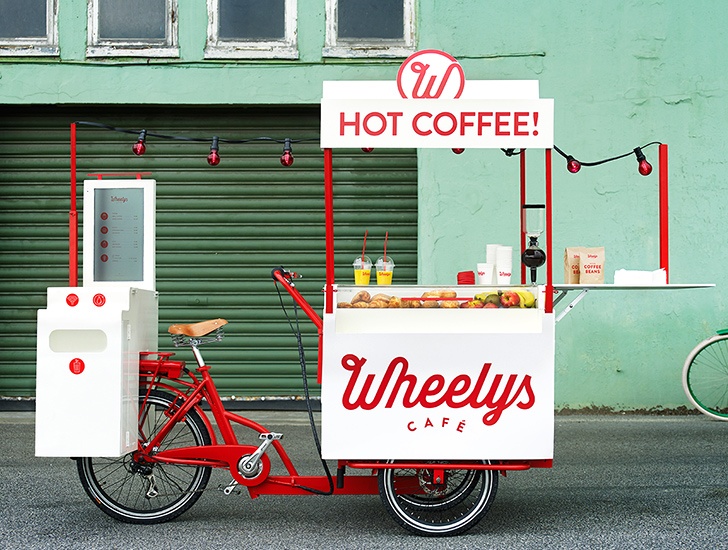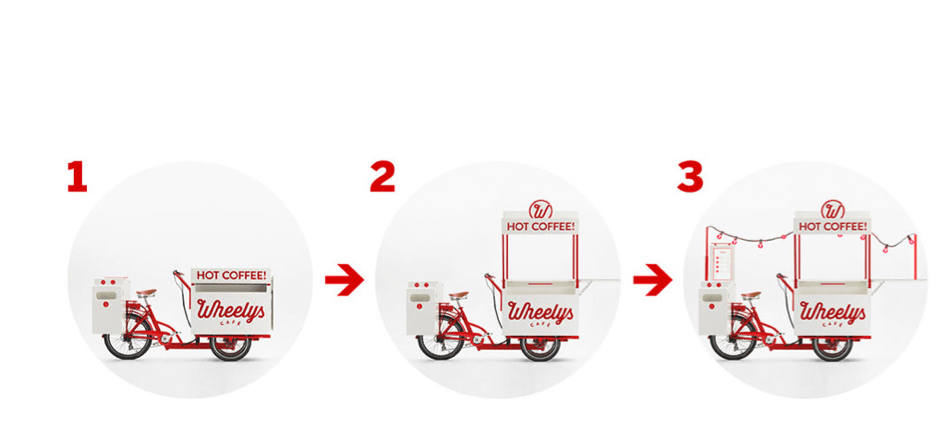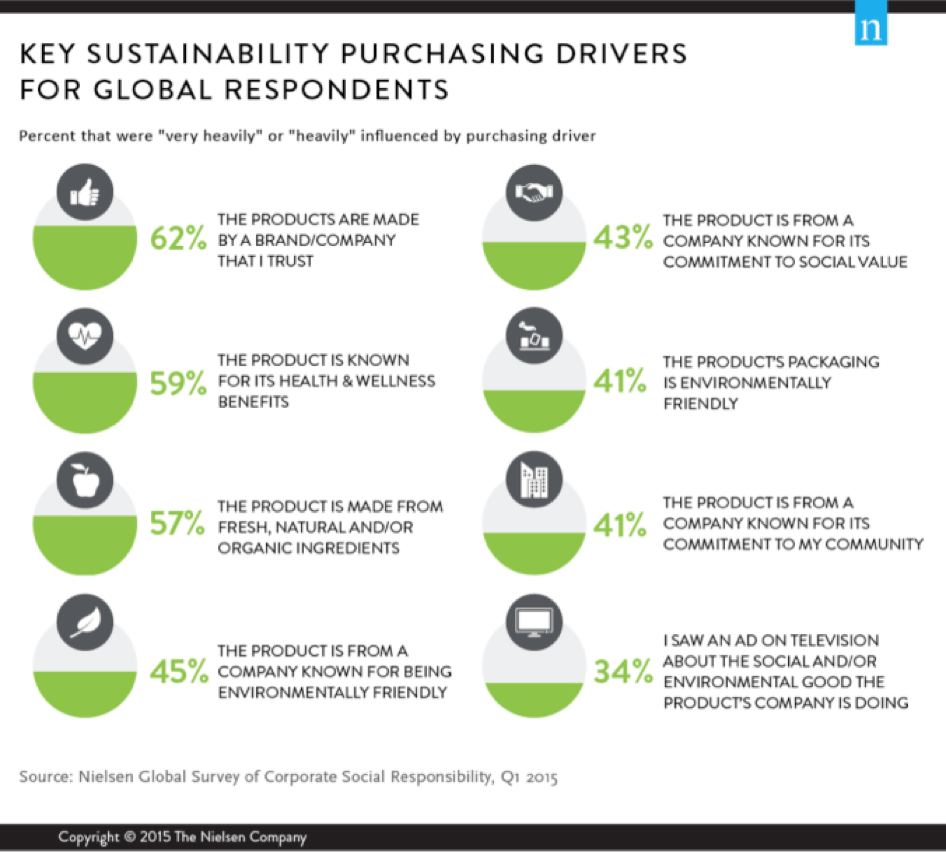It’s the World’s “Greenest Café”…and it’s on Wheels?

What do you get when you cross Scandinavian craftsmanship with Silicon Valley cash and add a heavy dose of caffeine? A “bike-powered coffee cart that could take on Starbucks” according to Fast Company.[1] Wheelys is a Stockholm-based coffee store company, without any stores. Instead, the company crafts and sells bicycle-mounted cafes to “young, hungry eco entrepreneurs from all over the world.”[2] These carts are well-tested, functional micro stores serving organic goods and run purely on solar and body power. With a price tag that is a fraction (around less than 1%) of ownership of a brick-and-mortar coffee shop, Wheelys is challenging the traditional café model with its mission to make the world “greener with every cup of coffee.” [2]
Wheels Up on Specialty Coffee
Coffee. It seems to be everywhere. On every block. In every hand and every Instagram. But according to the USDA, U.S. consumption is significantly lower than its peak in 1948 and global consumption is forecast to hit a record low in 2016.[3] What can explain this?
While consumption by volume is falling, something else is brewing: specialty coffee.* Consumption of specialty varietals rose threefold between 2000 and 2015.[4] And it is costing consumers; Americans spent a record $12.8 billion on coffee in 2015, and are expected to spend $13.6 billion in 2016.[5]
*Specialty coffee typically has one or more of the following characteristics: a) Grown using fair labor practices b) sourced with a focus on crop sustainability c) produced with a focus on quality d) shipped with a transparent and traceable supply chain
Wheelys Story
In 2014, a 25-year-old woman named Maria De La Croix was turned down from a job at Starbucks for having blue hair. In need of rent money, she and a few friends hand crafted the first Wheelys café, focusing on brewing fresh coffee.[6] The cart was built on top of a bicycle, enabling the rider to take a full service coffee operation anywhere their bike could go.
Two years later, Wheelys is operating cafes in more than 45 countries and is backed by investors including YCombinator, Paul Buchheit (creator of Gmail), Justin Waldron (co-founder of Zynga) and its future “Wheelers” through numerous rounds of crowd funded pre-orders.[2, 8]
Why Wheelys
Quick to start
Compared to opening a traditional café, opening a Wheelys has a much shorter lead time.
Affordable to start and maintain
A Wheelys café costs a fraction of a traditional café to start, opening up a new market of potential eco-entrepreneurs. Wheelys is also inexpensive to maintain with no rent or electricity contracts.
What customers want, where they want it
Wheelys distributes only 100% organic, high quality products.
Wheelys is also easy to transport, enabling café owners to even sell in multiple places within one day.
Making the world greener with every cup of coffee.
Not only are all Wheelys products 100% organic, its cafes are run only on sun and body power with newer models also incorporating wind power. Each café is not merely CO2 neutral, but carbon footprint negative.[2] This is in contrast to a business such as Starbucks’ where a high proportion of GHG emissions (1,342,419 metric tons of CO2 in 2015) are attributable to energy use in its physical stores.[7]
What is Brewing Ahead
Looking forward, Wheelys’ business is likely to meet increased demand related to its eco-conscious business model as a growing number of consumers are bringing climate change concerns into their purchasing decisions. In 2015, 45% of consumers answered that they were already “very heavily” or “heavily” influenced in their purchase decision by whether a product is from a company known for being environmentally friendly.[9]
However, these trends will also bring challenges. As competitors are taking note of these sustainability purchase drivers, many will attempt to flex their own environmental responsibility muscles. When they do, it will be across an expansive global presence, likely much larger and more visible than Wheelys’ current one. Starbucks is already taking steps in this direction, releasing an annual sustainability report with targets such as increasing in-store recycling and cutting CO2 emissions. These targets have become more aggressive and consumer facing in recent years and if done successfully, could pose a threat to Wheelys’ “sustainability story” as a leading differentiation point for customers and business owners.[7]
Wheelys should focus on two key areas in order to take advantage of opportunities related to the environment and mitigate the risks.
- Wheelys should internally honor its external brand identity. Although Wheelys cafes are “carbon neutral,” Wheelys should strive towards sustainable practices across its entire value chain from the way the coffee is grown all the way to manufacturing and shipping. In doing so, the company can minimize its negative impact on the environment and also avoid scrutiny and backlash over any inconsistencies in its brand identity as the company scales.
- Wheelys should bring its green mission to the forefront and ensure it is baked into each customer touch point and brand experience. This will help attract eco-minded consumers, spread awareness and further differentiate Wheelys. Examples of this include making all Wheelys products compostable or recyclable, subsidizing free coffee on Earth Day or selling Wheelys-branded bicycles to raise transportation pollution awareness. The company can also achieve this through innovations in its café designs as exhibited in the greenhouse attached to its Science Station (see exhibit below).
The Evolution of Wheelys
Wheelys 2 and 2.2
Wheelys 3
Wheelys Science Station
Wheelys 4
Sources
[1] Peters, A. (2014, April 4). The Bike-Powered Coffee Cart That Could Take On Starbucks. Retrieved from https://www.fastcoexist.com/3029125/the-bike-powered-coffee-cart-that-could-take-on-starbucks
[2] Company website
[3] Coffee: World Markets and Trade 2016/17. Retrieved from United States Department of Agriculture website: https://apps.fas.usda.gov/psdonline/circulars/coffee.pdf
[4] Vellucci, M. (2015, December 1). The Continued Rise of Premium Coffee in the U.S.: Will It De-Commoditize Coffee? Retrieved from https://www.bbh.com/en-us/insights/the-continued-rise-of-premium-coffee-in-the-u-s—will-it-de-commoditize-coffee-/10966
[5] Mintel Research. (2015, July 13). Mintel in the Media – This week’s highlights, 13th July 2015. Retrieved from http://www.mintel.com/blog/mintel-market-news/mintel-in-the-media-this-weeks-highlights-13-july-2015
[6] Thorpe, D. (2016, August 3). Don’t Tell Starbucks the Future is Coming on a Bicycle Wearing Blue Hair. Retrieved from http://www.forbes.com/sites/devinthorpe/2016/08/03/shhh-dont-tell-starbucks-the-future-is-coming-on-a-bicycle-wearing-blue-hair/#7e4999d3360f
[7] Tackling Climate Change | Starbucks Coffee Company. (2016). Retrieved from http://www.starbucks.com/responsibility/environment/climate-change
[8] Indiegogo. Wheelys. A café in a bike. Deal with it. Retrieved from https://www.indiegogo.com/projects/wheelys-a-cafe-in-a-bike-deal-with-it#/
[9] Nielsen. (2015). Sustainable Selections: How Socially Responsible Companies Are Turning a Profit. Retrieved from http://www.nielsen.com/us/en/insights/news/2015/sustainable-selections-how-socially-responsible-companies-are-turning-a-profit.html
All images courtesy of Wheelys
(Word count 795 excluded sources and titles)





















Really cool company and a superbly written blog post, Marcheta. The fourth iteration of the Wheely seems to be very elaborate; I especially like the WiFi router that is pretty imperative to modern coffee enthusiasts. But can this company really compete with Starbucks with this model? It seems built exclusively for ‘coffee-on-the-go’ types, which may make the router essentially redundant. Where do people sit? Is there limits to the range of coffees that they can offer given the limit workspace? And can this work in colder places or times of year where people do not want to be outside?
That all said, I genuinely find this a really appealing and environmentally-friendly concept. I assume this is a franchising model, which should allow them to scale at an accelerated rate. I’ll be on the lookout for one of these contraptions on my meandering travels.
This is a fascinating organization, Marcheta. I have to say I’m most intrigued by the statistic that “45% of consumers answered that they were already ‘very heavily’ or ‘heavily’ influenced in their purchase decision by whether a product is from a company known for being environmentally friendly.” To Anton’s point, I wonder how the degree of environmental friendliness matters, or do things like having a place to sit outweigh the value a neutral carbon footprint. The other thing that strikes me is that this is a model that is easy to replicate. If the coffee trend heads in this direction, it could be great for the environment, but may dilute Wheely’s market penetration.
What a great concept! I think it’s incredible that unlike some of the retail giants others have wrote about that are reversing many of their policies to be more sustainable, Wheely’s started their company with concern for the environment as a core component of their business model. I also really like the idea of eco-entrepreneurs, and would be interested in seeing what partnerships or offshoot businesses Wheely’s explores as they expand in order to capitalize on the market of entrepreneurs who are concerned about the environment. I can see the mobile retail bike as being applicable to several other lines of business, such as convenience shops or retail for accessories.
I think this is a very interesting concept and even though I haven’t seen one and don’t drink coffee, I believe it can work. However, I would question two things:
1. Regarding the statistic on the number of people who care about environmental impact: I am not convinced that this statistic can be fully trusted. Not because of the statistic but because many people say one thing and do something different especially when it comes to the environment. Most people say they care but if they are offered a cheaper alternative for the same quality, many will not be willing to pay much extra for the environment. Like you argue, I also believe they should target those people who do care.
2. I am not sure the concept of essentially “food/drinks trucks” makes eating and drinking necessarily more sustainable. I believe it really depends on what your base is. If e.g. you compare to Starbucks, sure, but if you compare to making a big jug of coffee at home and drinking it from mugs rather than single-use cups, the environmental friendliness of this concept is less obvious.
This is really neat and something I had not heard of previously, so thanks for sharing. I really wonder, to Anton’s point, what Wheelys can do to operate in colder climates or in areas where solar and wind power are not available to be harnessed in large quantities? Is this scaleable to all geographies? Perhaps in these locations, as the “Day with Wheelys” described, they can operate indoors at malls, train stations, etc. It could be possible to partner with specific business and wheel around lobby to lobby. I’m also wondering if they offer espresso-based drinks such as lattes, mochas, etc. in order to truly compete with Starbucks.
As a non-coffee drinker I have a hard time relating to the “specialty coffee” craze. Nonetheless, I think this is a really unique, innovative business model. However, we need to be realistic. Is Wheelys really going to expand and become the next large coffee chain? I’m doubtful-the chain has very low barriers to entry which means that almost anyone anywhere can open one, but that doesn’t guarantee long-term success or strategy. The graph comparing its country footprint to Starbucks is not a fair comparison. I also doubt whether or not Starbucks is actually influenced by Wheelys in terms of driving sustainable practices. Chances are that Starbucks is looking towards its fellow Fortune 500 companies and large coffee chain competitors to set the tone for their sustainability practices. That being said, I agree that a huge value add for Wheelys is to raise awareness of the importance of a) drinking sustainably sourced coffee and b) climate change efforts.
I’d really like to know more about the bikes that Wheelys uses for these street shops. It’s wonderful to tout how organic your sourcing is and use renewable energy, but the bikes also need to be sourced from sustainable materials, manufactured in a sustainable way, transported sustainably, and not cause harm to the environment when disposed. After all, bikes are usually made with less sustainable materials–paint, rubber, and metal. It would be very ironic to grow this business to raise climate change awareness, but in fact you are doing the environment much harm by increasing demand for unsustainable bikes.
Parker
Really love the concept – I had not heard of Wheelys before! Interesting read. Regardless about whether they can take on SBUX, reaching 44 countries is super impressive. The bikes look super cool and I agree could be applied to other mobile markets. On the cold weather issue, it’s interesting that Wheelys is in Canada and Northern Europe. Though it’s not clear where exactly the bikes typically reside in those countries, it seems as if folks who have decided to join Wheelys are making to make sure the investment math is favorable despite the snow patterns. I’m also a skeptic about consumers, millennials or not, making purchasing decisions based on the level of environmental sustainability. To me, it’s probably something that functions more at the margin after meeting price, taste, convenience, and service standards so it’s a little concerning that sustainability is marketed as Wheelys main value prop. Lastly, I wonder how Wheelys manages its fleet – specifically, whether or not it knows if bike shop owners lease their portable shops to others during their downtime.
What an interesting company! Thoroughly enjoyed a very visual read. As with Clif Bars (and perhaps even more so in this case), when a company builds its external brand around sustainability, there is almost a sliding scale that ends with ‘never enough’ in terms of corporate sustainability practices. In the case of coffee consumption, where paper products are so integral to current consumer behavior, I would like to see Wheely’s put a full force campaign around re-usable coffee cups from Wheelys and discounting based on that. If they are location based, perhaps they could move to a subscription-based program to increase loyalty among the user base, which many cafes attempt to do using loyalty cards.